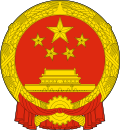District-free city
A district-free city ( Chinese 地 級 市 / 地 级 市 , Pinyin dìjíshì ) is an administrative unit in the People's Republic of China below the provincial level. There are currently 293 prefecture-level cities in the PRC (as of February 16, 2019).
The administrative area of a district-free city usually includes both the actual city area and the surrounding greater region, i.e. extensive rural areas. That is why district-free cities are made up of city districts, independent cities and counties (in Inner Mongolia also banners ).
Such an administrative area often has the size and population of a German federal state: The administrative area of the city of Changchun with six urban districts, three independent cities and one district comprises a total of 7.12 million inhabitants on an area of 20,565 km², the state of Hesse for comparison 6 . 07 million inhabitants on an area of 21,115 km².
District level administrative systems
In the administration of China there is the district level ( 地 級 / 地 级 ) below the provincial level . At this level, a distinction is made between district-free cities, administrative districts ( 地區 / 地区 ), alliances ( 盟 ) and autonomous districts ( 自治州 ).
District-free cities and autonomous districts are administrative divisions of the first degree, i. i.e., they have - such as B. the superior provinces and the subordinate districts - via both chambers of parliament ( People's Congress and Consultative Conference ), as well as via a people's government ( 人民政府 ), which is elected by the People's Congress of the city or the autonomous district.
Administrative districts and federations, on the other hand, are administrative divisions of the second degree, namely "provincial central authorities", i.e. That is, they have no people's congresses, no consultative conferences and, above all, no people's governments. Instead, they have an administrative office ( 行政公署 ) as government. The administrative office is set up by the higher provincial government.
Conversion into district-free cities
Since November 5, 1983, the number of district-free cities has increased, since administrative districts and confederations are converted into such. This transformation means a strengthening of the middle administrative level, a form of administrative decentralization, because such extensive competencies and responsibilities are shifted from the provincial to the district level.
Sub-provincial cities
By a government resolution of February 25, 1994, 15 prefecture-level cities were declared sub-provincial cities . The Lord Mayor of a sub-provincial town has the same rank as the Vice-Governor of a province. These 15 cities have a much higher degree of rights, competencies and responsibilities, especially in the areas of justice and economics, than the other 271 prefecture-level cities.
literature
- Sebastian Heilmann : Political System, 3rd People's Republic. In: Stefan Friedrich, Hans-Wilm Schütte, Brunhild Staiger (eds.) The great China Lexicon. History, geography, society, politics, economy, education, science, culture. Wissenschaftliche Buchgesellschaft, Darmstadt 2003, ISBN 3-534-14988-2 , pp. 575-578.
- Erling von Mende , Heike Holbig: Local administration. In: Stefan Friedrich, Hans-Wilm Schütte, Brunhild Staiger (eds.) The great China Lexicon. History, geography, society, politics, economy, education, science, culture. Wissenschaftliche Buchgesellschaft, Darmstadt 2003, ISBN 3-534-14988-2 , pp. 456–458.
- Meyer's Atlas China. On the way to world power. Bibliographisches Institut AG, Mannheim 2010, ISBN 978-3-411-08281-0 , pp. 92-93.
- Yin Zhongqing (尹中卿): The political system in China today. China Intercontinental Press, Beijing 2004, ISBN 7-5085-0470-4 .
